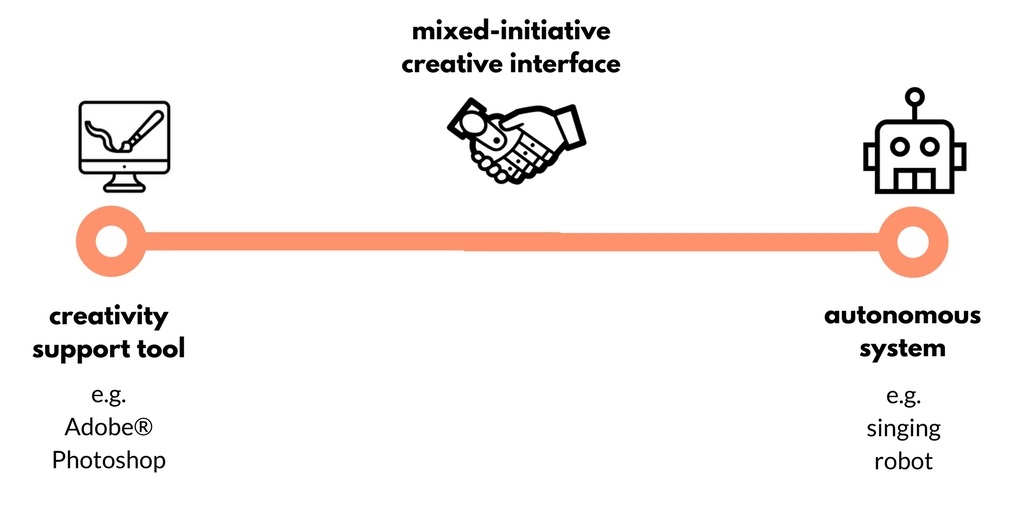We define mixed-initiative creative interfaces (MICIs) as systems that allow for the collaboration of humans and computers in creative domains like games, film, writing, music, fashion, design, visual art, etc.
MICIs put a human and computer in a tight interactive loop, where both the human and the computer provide necessary, non-deterministic inputs into the creative process.

Criteria
For a MICI to be included in the Library, it must meet the following criteria:
1.1 Creative process support
The computer and the human engage in a creative process of combination, exploration and/or transformation.
Note: ‘Combination and exploration’ refer to Margaret Boden’s definition of creative process. Combination: ‘making unfamiliar combinations of familiar ideas.’ Exploration: ‘explor[ing] a structured conceptual space, mapped by a particular style’ or convention within a creative field (e.g. style of painting, rules of a sonnet). Boden, M. A. (2007). Creativity in a nutshell. Think, 5(15), 83-96.
1.2 Creative domain output
The system supports producing artifacts or ideas in domains of creative practice (such as the fine arts or variants of design).
For example, a tool for automatically testing and ensuring the structural soundness of physically manipulated architectural models (creative process and creative domain).
1.3 Creative intent
The system is designed with the intention of supporting a creative process in a domain of creative practice.
For example, Photoshop is designed with the intention to enable painting.
2.1 Mixed input
Both human and computer provide necessary inputs into the creative process – the computer could not produce artifacts or ideas without human input, nor the human without computer input.
2.2 Autonomous input
Both human and computer can provide non-deterministic inputs into the creative process – their inputs are not fully pre-determined by the other party.
2.3 Dialogue
Both human and computer can register and respond to the other party’s input with new or revised input.
For example, a system where the human draws a painting, the computer generates a series of captions, and the human selects the most fitting caption.
For example, a system where the computer produces a caption, the human draws a painting, and the computer evaluates and expresses how much it likes the painting.
Graphs in each system page visualize the creative process through which the human and the computer engage in to generate creative output. In most cases, the graph will either have an internal loop of subprocesses that might repeat during the creative process, while most of the system imply that the process can be iterative as a whole.
Subprocesses are events that can happen during the creative process. We identify the following subprocesses as important steps in the creative flow:
- Ideate – create high-level concept(s) that need production to be a fully realised artefact
- Constrain – set limitations on the desired artefact
- Produce – create artefact(s)
- Suggest – create artefact options to be chosen by another agent
- Select – choose satisfying artefact
- Assess –provide an explicit evaluation of the artefact
- Adapt – adjust existing artefact
Symbols:
 Starting subprocess of the creative process.
Starting subprocess of the creative process.
 Occurring subprocess in the creative process.
Occurring subprocess in the creative process.
 Final subprocess of the creative process. Can be multiple points, if the system is designed that way.
Final subprocess of the creative process. Can be multiple points, if the system is designed that way.
![]() Reoccurring subprocess. Does not necessarily need to be a part of the flow, can happen at any time of the creative process.
Reoccurring subprocess. Does not necessarily need to be a part of the flow, can happen at any time of the creative process.